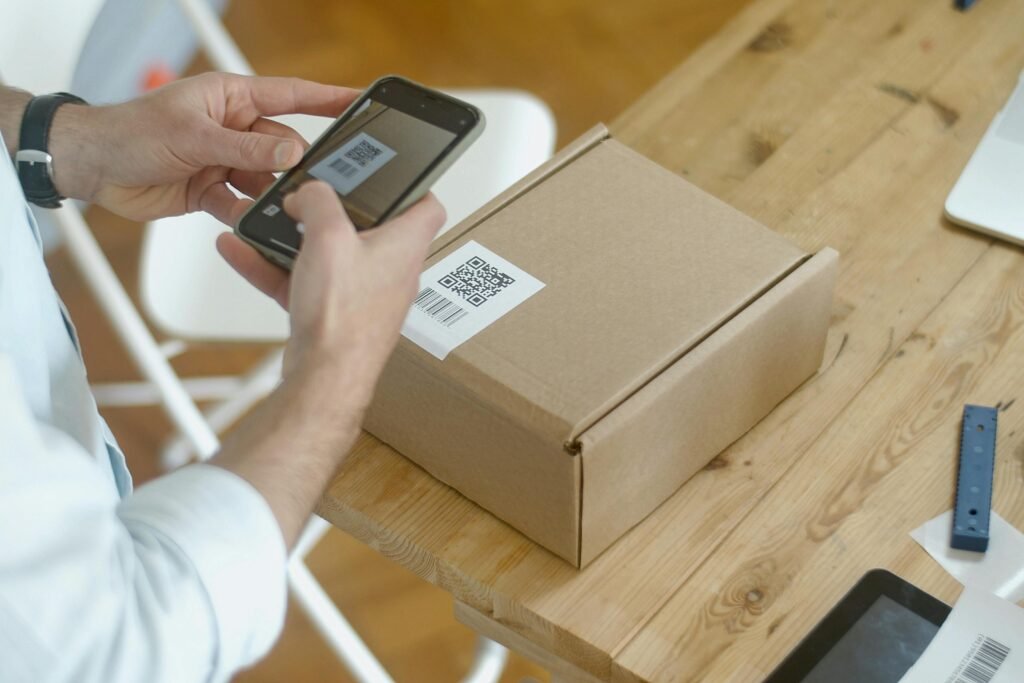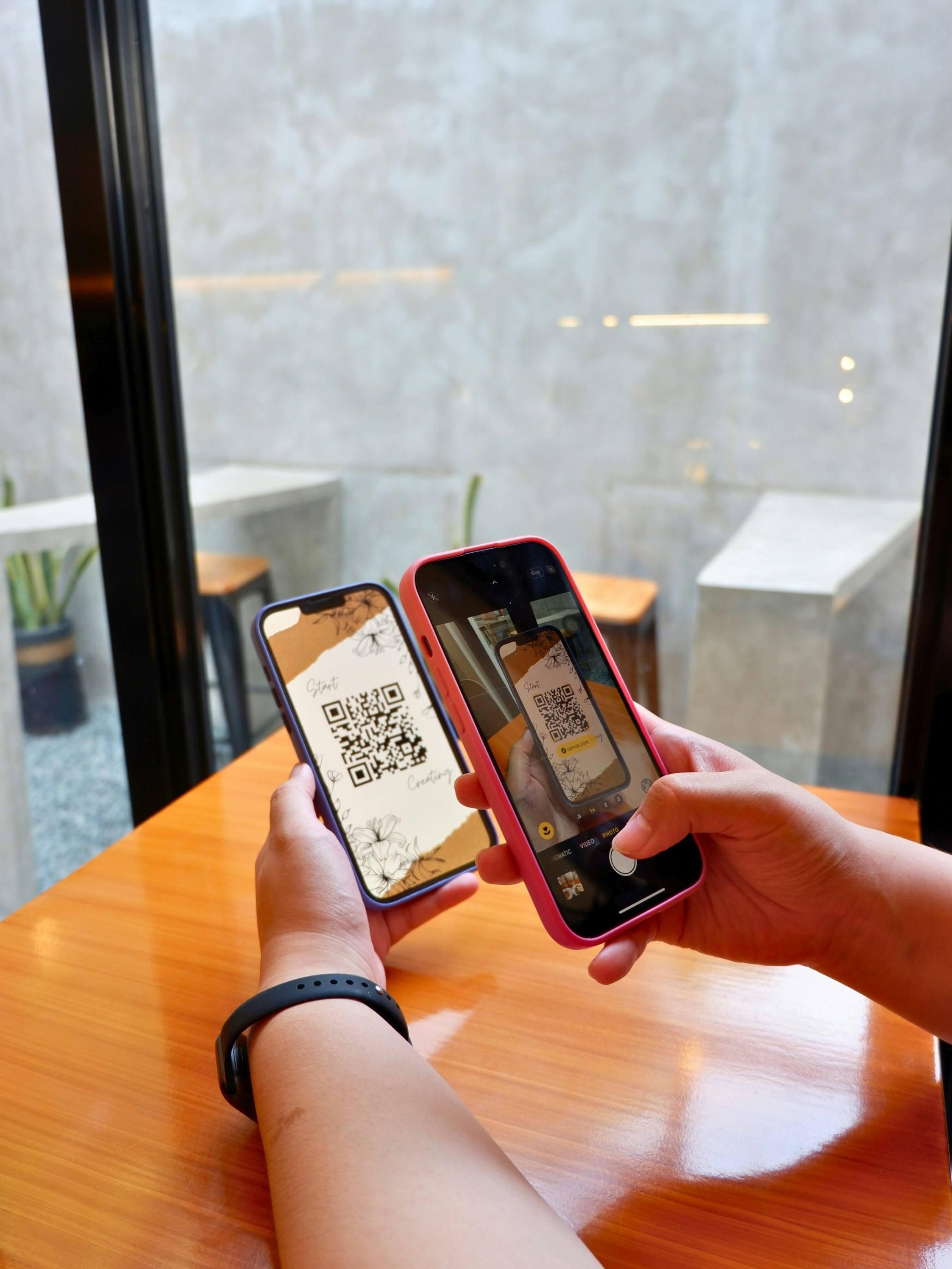Introduction to QR Codes
QR codes, or Quick Response codes, represent a significant advancement in the realm of barcode technology. Originally developed in the early 1990s by a Japanese company named Denso Wave, these two-dimensional barcodes were designed with the intention of tracking automotive parts during the manufacturing process. The use of QR codes quickly expanded due to their ability to store substantial amounts of information that can be easily scanned by various devices.
A QR code encapsulates data in a grid of black squares arranged on a white background, creating a matrix that can be interpreted by cameras and scanners. This capability allows users to access information rapidly and conveniently, making QR codes an essential tool for various applications beyond their original purpose. Today, they are widely utilized in marketing, advertising, payment systems, and ticketing, among other areas. The functionality of QR codes extends beyond traditional barcodes, which typically require a line-of-sight scan and can only hold limited information.
As the digital landscape continues to evolve, QR codes have gained popularity for their simplicity and efficiency. Users can quickly encode a URL, contact information, or promotional content into a QR code, allowing for easy interaction with consumers. This has become particularly relevant in the context of mobile technology, as smartphones equipped with cameras can effortlessly scan QR codes, connecting users to online content without the need for manual data entry.
In essence, QR codes serve as a bridge between the physical and digital worlds, enabling streamlined access to information. Their ongoing relevance in diverse fields highlights their adaptability and significance in modern communication. With continual advancements in technology, the potential applications of QR codes are expected to grow, further integrating them into everyday life.
How QR Codes Work
QR codes, short for Quick Response codes, are two-dimensional barcodes that allow for the storage and transmission of information in a compact and efficient manner. The structure of a QR code consists of several key components that facilitate its functionality. At a basic level, a QR code is made up of black squares arranged on a white grid, which can be scanned using a smartphone or a dedicated QR code reader.
One of the most significant elements of a QR code is the positioning markers located at three corners of the code. These markers enable the scanner to identify the QR code’s orientation and align it accurately for decoding. Additionally, QR codes include a timing pattern that helps the scanner determine the size of the data matrix and enhances the reliability of the reading process. The data is encoded within the modules, which are the smaller squares that make up the code.
The encoding process involves converting data into a pattern of black and white squares. This is done using Reed-Solomon error correction, which ensures that even if the QR code is partially damaged or obscured, the encoded information can still be retrieved. Furthermore, the capacity of a QR code can vary based on the amount of data it contains, which can range from numeric and alphanumeric characters to binary and kanji symbols.
When a QR code reader scans a code, it captures an image of the code and processes the data through a series of algorithms. The reader detects the positioning markers, interprets the modules, and decodes the information encoded within. This seamless interaction between the QR code structure and the reader enables users to quickly access the information stored, making QR codes a versatile tool in today’s digital landscape.
Types of QR Codes
QR codes, or Quick Response codes, come in various types, each serving distinct purposes based on user needs. Understanding these types is essential for effectively leveraging this technology. The two primary categories of QR codes are static and dynamic QR codes, with each type offering unique features and functionalities.
Static QR codes encode fixed information that cannot be altered once generated. These codes are straightforward and suitable for scenarios where the content is unlikely to change, such as linking to a website or displaying contact information. Due to their unchangeable nature, static QR codes can be printed on physical materials like brochures or product packaging without concern for future updates. However, the lack of flexibility means any errors in the original coding cannot be rectified without generating a new code.
Dynamic QR codes, in contrast, allow for information to be edited post-creation. This capability is particularly beneficial for marketing campaigns and promotions where content may need frequent updates. Users can modify the URL embedded in the dynamic QR code to direct consumers to different landing pages or to update product information seamlessly. Additionally, dynamic QR codes can track data, including scans and user interactions, providing businesses with valuable insights into consumer behavior.
Within these categories, several specialized versions of QR codes exist, tailored to specific applications. For example, URL QR codes directly link consumers to online websites, while vCard QR codes store contact details, making it easy for users to save information directly to their address book. Other versions include event QR codes, which can RSVP to invitations, and social media QR codes that link to profiles on various platforms. Choosing the appropriate type of QR code depends largely on the intended use, as each offers unique advantages suited to different scenarios.
Applications of QR Codes
QR codes, or Quick Response codes, have become integral to various sectors, enhancing user engagement and streamlining processes. One of the most prominent applications is in the retail industry, where businesses utilize these codes for product information, promotional campaigns, and inventory management. Consumers can scan QR codes in stores to access detailed product descriptions, reviews, and even coupons, thereby improving their shopping experience.
In the realm of marketing, QR codes serve as a bridge between offline and online channels. Marketers often incorporate them into printed advertisements, allowing consumers to easily connect with online content, subscribe to newsletters, or participate in social media campaigns. This interactivity not only helps in measuring campaign effectiveness but also fosters greater consumer retention.
Another significant application of QR codes is in payment systems. The rise of digital wallets and contactless payments has led to smartphones being used more frequently for transactions. By scanning QR codes displayed at checkout, customers can complete purchases rapidly and securely, thus minimizing physical contact and increasing transaction speed. This ease of use is particularly beneficial in food services, where QR codes often replace traditional menus, allowing diners to view offerings and place orders directly from their devices.
QR codes also find valuable applications in the tourism sector. Travelers can scan codes at attractions to access information in different languages, including historical facts and logistical details. This accessibility improves a tourist’s experience, offering instantaneous data at their fingertips.
Lastly, the healthcare industry has embraced QR codes for patient management. Hospitals and clinics utilize them for patient check-ins, access to medical records, and appointment scheduling. This utilization not only enhances operational efficiency but also prioritizes patient privacy and safety, facilitating a seamless healthcare experience.
Creating Your Own QR Code
Creating a QR code is a straightforward process that can be accomplished with the help of various online QR code generators. These platforms allow users to input information that they would like to encode, making it accessible via a quick scan. The first step is to decide what type of information you want to share; this can include URLs, contact details, text, or even payment information. Once you have this decided, you can access any of the numerous QR code generation websites available, such as QR Code Generator or QRStuff.
After selecting a QR code generator, you will typically encounter an input field where you can paste the desired content. For example, if you want to share a link to your website, simply input the URL. Some generators also allow you to add features such as logos or images, giving you the opportunity to customize the design of your QR code. Customization not only enhances the visual appeal but also aligns the QR code with your branding strategies, ensuring that it is instantly recognizable to your audience.
One important aspect to consider is tracking the effectiveness of your QR codes. Many advanced QR code generators offer analytics features that provide insights into how often your code has been scanned, the geographic locations of scans, and the type of devices used. Utilizing these features allows you to measure the success of your QR code campaigns and adjust your strategies accordingly. Regularly reviewing these statistics can provide valuable feedback and help optimize future marketing efforts. By following these steps, you can create effective, functional, and visually appealing QR codes that serve your intended purpose effectively.
Scanning QR Codes
Scanning QR codes has become an essential skill in our digitally-driven era, as these codes provide a quick method for accessing information, websites, and applications. Most commonly, smartphones, equipped with built-in cameras and dedicated apps, are the primary devices used to scan these codes. Users can effortlessly scan a QR code by aiming their smartphone camera at the code. However, the specific process may differ based on the operating system being used.
For iPhone users, the scanning process is relatively seamless. The built-in Camera app supports QR code recognition directly. When the user positions the camera towards the QR code, a notification will prompt them to tap to open the relevant link. Additionally, iOS offers a dedicated QR code scanner within the Control Center, ensuring easy access. Users are also encouraged to keep their iOS version updated to enjoy the latest features and optimizations.
Similarly, Android devices have integrated QR scanning capabilities into their default camera application in many recent models. Users can simply launch the camera app, point it at the QR code, and a pop-up will appear, allowing them to access the encoded information. For devices lacking this capability, third-party apps, such as QR Code Reader, can be downloaded from the Google Play Store for efficient scanning.
While scanning, users might encounter common issues, such as difficulty in recognition due to poor lighting or distance. Ensuring that the code is properly lit and within a reasonable range can help improve scanning success rates. Furthermore, a steady hand while taking the picture can mitigate blurriness, enhancing recognition accuracy. If users experience persistent difficulties, consider checking for any updates on the scanning app or device software and refer to support materials for troubleshooting guidance. These steps can help ensure a smooth and efficient QR code scanning experience.
Safety and Security Concerns
As QR codes become increasingly prevalent in various aspects of daily life, it is essential to address the potential safety and security concerns that may arise from their use. One significant risk associated with QR codes is the susceptibility to phishing attacks. Cybercriminals can create fake QR codes that, when scanned, redirect users to fraudulent websites designed to harvest personal or sensitive information. Such malicious redirects can lead to disastrous outcomes for unsuspecting users.
Another concern is the possibility of malware installation. Scanning a compromised QR code can trigger downloads of harmful software onto devices, which may jeopardize the security of financial or personal data. These risks underscore the need for users to remain vigilant about the QR codes they choose to interact with, especially in public spaces or situations where a code may be tampered with.
To ensure safety when scanning QR codes, users should adopt several precautionary measures. First, it is advisable to avoid scanning QR codes from untrusted sources. When encountering a QR code in a public location, such as a restaurant or on promotional material, one should verify the code’s legitimacy. This may involve checking the surrounding context to ensure that it appears authentic and aligns with the expected source.
Additionally, it is prudent to utilize a QR code scanner that provides previews of the link before proceeding to visit the site. This feature allows users to assess the URL for red flags such as unusual domain names or suspicious patterns. Keep your device’s security software up to date, as this may offer an additional layer of protection against potential threats.
By remaining aware of these risks and following best practices, users can significantly reduce their vulnerability to QR code-related security issues.
Future Trends in QR Code Technology
As digital technology continues to evolve, QR codes are poised to adapt and thrive across various sectors, driven by innovations and changing consumer behaviors. One prominent trend is the integration of QR codes with augmented reality (AR). By pairing QR codes with AR experiences, businesses can provide users with immersive interactions. For example, scanning a QR code may allow consumers to visualize how a product would look in their living space, thereby enhancing the shopping experience and increasing conversion rates.
Another vital aspect of the future of QR codes is their enhanced tracking capabilities. As data analytics become more sophisticated, businesses are leveraging QR codes to gather real-time insights about consumer interactions. This advancement will allow companies to assess the effectiveness of marketing campaigns, understand consumer preferences, and refine strategies accordingly. The ability to track user engagement will support an informed approach to tailored experiences, leading to increased customer satisfaction and loyalty.
The role of QR codes in contactless transactions is also evolving significantly. With the rise of digital wallets and payment systems, QR codes are becoming an integral component of cashless transactions. They provide a quick, secure, and user-friendly method for consumers to make purchases or access services without physical contact. As health safety becomes a more prominent concern, we can anticipate an increased reliance on QR codes in sectors such as hospitality, retail, and transportation.
Moreover, QR codes are expected to gain traction in the fields of education and entertainment. By incorporating interactive elements, educators can engage learners in novel ways, while event planners might use QR codes to streamline ticketing processes. As these trends develop, businesses and organizations will continue to explore innovative applications of QR codes, ensuring they remain relevant in a rapidly changing digital landscape.
Conclusion
In recent years, QR codes have transformed from a niche technology into a mainstream tool that plays a significant role in our daily interactions with digital content. Initially designed for tracking automotive parts, their evolution has seen them become essential in various sectors such as retail, marketing, and information sharing. This shift highlights their versatility and relevance in today’s fast-paced digital landscape.
QR codes offer an efficient way for businesses to connect with consumers, enabling access to promotions, product information, and services with a simple scan. This convenience caters to the modern consumer’s desire for quick information without the need for cumbersome web addresses or lengthy searches. Whether utilized in advertising campaigns, restaurant menus, or payment systems, QR codes facilitate seamless communication and enhance the overall user experience.
Furthermore, as mobile technology continues to advance, the applications of QR codes are likely to expand even further, incorporating features such as enhanced security and personalized content. Their ability to bridge the physical and digital worlds positions QR codes as a pivotal element in marketing strategies aimed at enhancing consumer engagement. Businesses that effectively leverage this technology can gain a competitive edge by meeting consumers at their point of interest.
In summary, QR codes have evolved into a multifaceted tool that is essential for both consumers and businesses alike. Their widespread adoption is a testament to their practicality and adaptability, and as technology continues to advance, they are sure to maintain their significance in facilitating quick access to information while fostering deeper connections between brands and their customers.
© barcodly.com- All rights reserved





